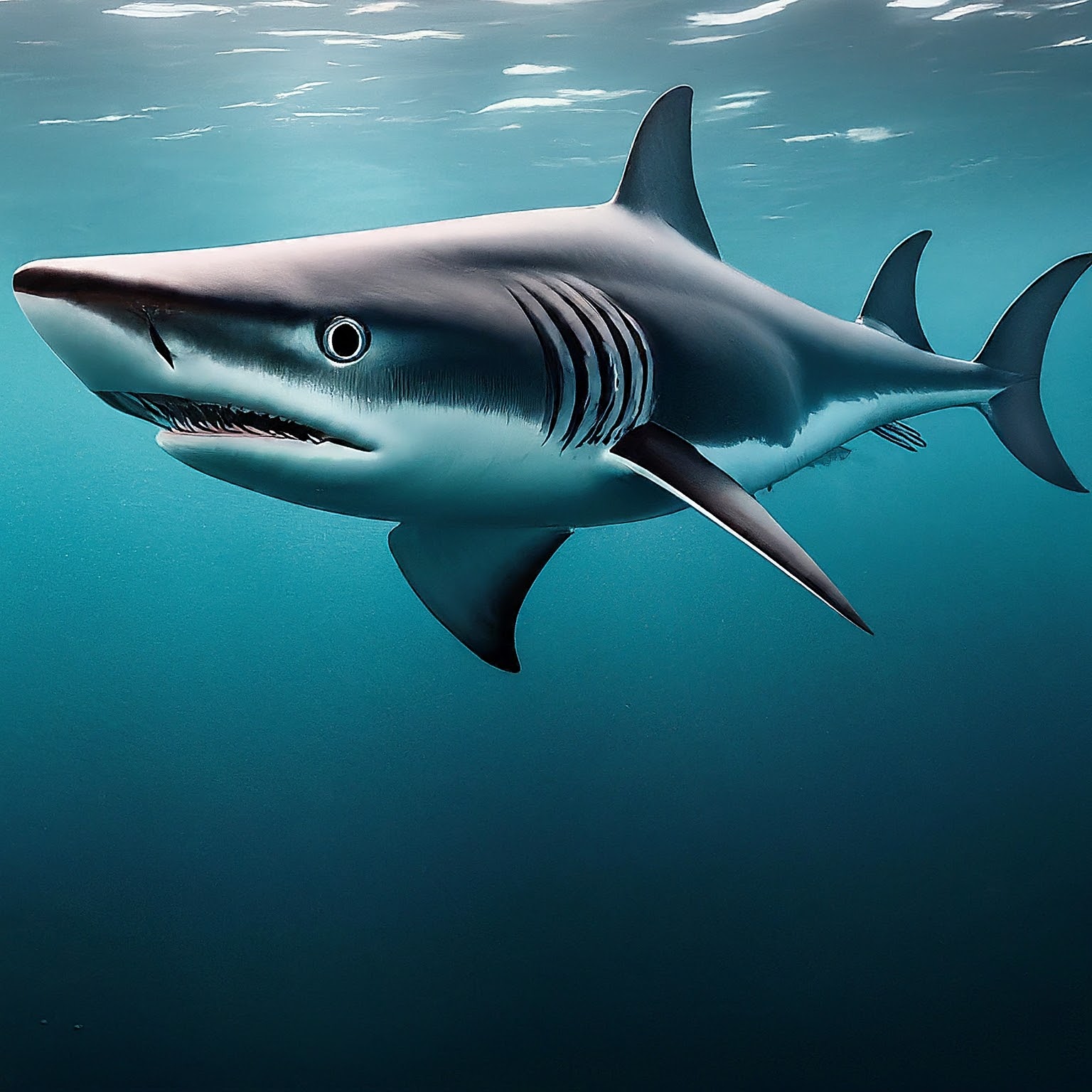The Porbeagle Shark (Lamna nasus) is a fascinating marine species that prowls the depths of the world’s oceans. This article aims to explore various aspects of the Porbeagle Shark, including its scientific classification, identification, physical characteristics, types, distribution, diet, reproductive strategies, conservation status, and its role in the intricate marine food web.
Porbeagle Shark Scientific Classification
Before delving into the details, let’s establish the scientific classification of the Porbeagle Shark:
- Kingdom: Animalia
- Phylum: Chordata
- Class: Chondrichthyes
- Order: Lamniformes
- Family: Lamnidae
- Genus: Lamna
- Species: nasus
Porbeagle Shark Identification, Appearance, and Anatomy
Identification
The Porbeagle Shark is recognized by several distinctive features:
- Body Shape: Streamlined and fusiform, contributing to its swift swimming capabilities.
- Coloration: Dark gray to bluish-gray on the dorsal side, transitioning to a lighter shade ventrally.
- Dorsal Fin: Prominent, triangular, and marked with a white patch at the rear base.
Anatomy
Understanding the internal and external anatomy provides insights into the Porbeagle’s adaptations:
- Teeth: Small and pointed, adapted for capturing and holding onto prey.
- Eyes: Large and well-adapted for low light conditions.
- Pectoral Fins: Long and pointed, aiding in maneuverability.
Porbeagle Shark Physical Characteristics
Exploring the physical traits of the Porbeagle Shark enhances our appreciation for its ecological niche:
- Size: Adult Porbeagles typically reach lengths of 6 to 8 feet, although larger individuals have been recorded.
- Weight: Adult weights range from 200 to 300 pounds on average.
- Temperature Regulation: The Porbeagle is endothermic, capable of maintaining a higher internal body temperature than the surrounding water.
Porbeagle Shark Types and Varieties
The Porbeagle Shark does not have recognized subspecies or distinct varieties within its classification.
Porbeagle Shark Weight, Height, Size, and Teeth
Understanding the dimensions and dental features of the Porbeagle Shark provides insights into its ecological role:
- Weight Variation: Adult Porbeagles generally weigh between 200 to 300 pounds, with variations based on age and sex.
- Length: Ranging from 6 to 8 feet, Porbeagles are formidable predators in their marine habitats.
- Teeth Structure: Small and pointed teeth are adapted for a varied diet.
Porbeagle Shark Distribution, Migrations, and Habitat
Unraveling the geographical range, migratory patterns, and preferred habitats of Porbeagle Sharks provides insights into their ecological roles:
- Global Distribution: Porbeagles inhabit both sides of the North Atlantic and have been recorded in various other locations, including the Southern Hemisphere.
- Migratory Behavior: They exhibit extensive migratory patterns, often covering vast distances.
- Habitat Preference: Porbeagles are found in cold to temperate waters and are commonly associated with continental shelves and slopes.
Porbeagle Shark Food and Diet
The dietary preferences of Porbeagle Sharks contribute to their crucial roles in marine food webs:
- Feeding Behavior: Porbeagles are opportunistic predators, preying on a variety of fish, squid, and even small marine mammals.
- Prey Selection: Their diet includes species like mackerel, herring, and squid, showcasing their position as versatile carnivores in the marine ecosystem.
Porbeagle Shark Reproduction and Lifespan
The reproductive biology and lifespan of Porbeagle Sharks reveal aspects of their life histories:
- Ovoviviparous Reproduction: Female Porbeagles give birth to live pups after the eggs hatch within their bodies.
- Litter Size: Generally, a small number of pups are born in each reproductive cycle.
- Lifespan: The average lifespan of Porbeagle Sharks is estimated to be around 20 to 25 years.
Porbeagle Shark Conservation, Efforts, and Threats
As marine ecosystems face increasing pressures, understanding the conservation status, ongoing efforts, and potential threats to Porbeagle Sharks is crucial:
- Conservation Status: The Porbeagle Shark is listed as Vulnerable on the International Union for Conservation of Nature (IUCN) Red List.
- Overfishing: Intensive fishing for their meat and fins poses a significant threat to Porbeagle Shark populations.
- Management Measures: Various regions have implemented management measures, such as quotas and fishing regulations, to address conservation concerns.
Porbeagle Shark Predators and Preys
Despite their status as apex predators, Porbeagle Sharks face potential threats from larger predators and human activities:
- Predators: Larger sharks, such as great whites, may prey on Porbeagle Sharks, especially juveniles.
- Human Activities: Overfishing and bycatch in commercial fisheries represent significant threats to Porbeagle Shark populations.
Porbeagle Shark Facts
- Warm-Blooded Adaptation: The Porbeagle Shark is one of the few shark species capable of maintaining a higher internal body temperature, allowing it to thrive in colder waters.
- Commercial Fishing: Historically targeted for its valuable meat and fins, the Porbeagle has faced significant population declines due to overfishing.
Porbeagle Shark Related FAQ’s
- Why is the Porbeagle Shark Warm-Blooded?
- The Porbeagle is warm-blooded, or endothermic, which helps it remain active and agile in colder waters.
- What Threats do Porbeagle Sharks Face?
- Porbeagle Sharks face threats from overfishing, both for their meat and fins, as well as bycatch in commercial fisheries.
- How Can Conservation Efforts Help Porbeagle Sharks?
- Conservation efforts involve implementing and enforcing fishing regulations, establishing marine protected areas, and raising awareness about the importance of preserving these apex predators.
Conclusion
In conclusion, the Porbeagle Shark stands as a testament to the marvels of oceanic life, showcasing adaptability, grace, and a vital role in maintaining the balance of marine ecosystems. As we navigate the complexities of conservation and sustainable fisheries management, it becomes imperative to recognize the vulnerability of the Porbeagle and work collectively towards ensuring its continued presence in our oceans. Through science-based management, responsible fishing practices, and global cooperation, we can contribute to the preservation of this magnificent species, allowing future generations to witness the elegance and significance of the Porbeagle Shark in the vast expanses of the world’s seas.
